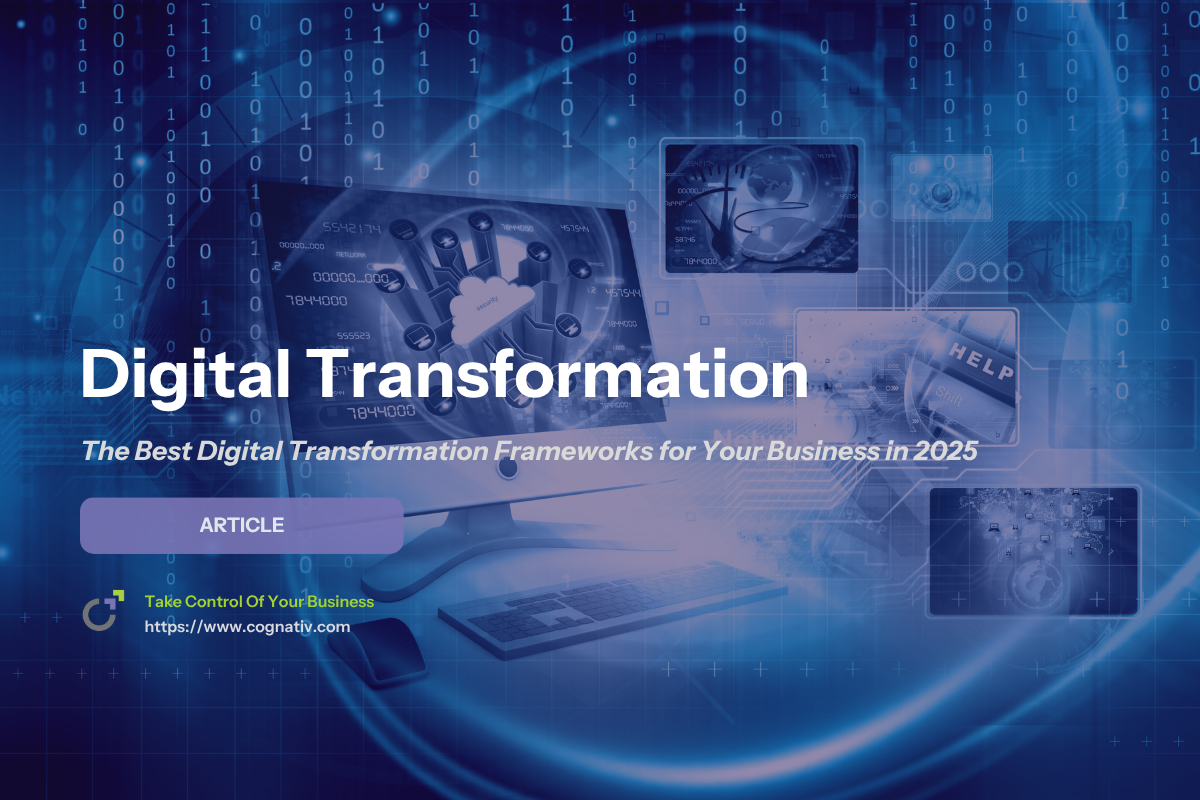The Best Digital Transformation Frameworks for Your Business in 2025
Looking to navigate digital transformation effectively? Digital transformation frameworks offer structured approaches to guide your business through technological changes. They help align your digital efforts with strategic goals, mitigate risks, and optimize resources. In this article, we will explore the best digital transformation frameworks for 2025, helping you identify the best ways to achieve your digital transformation objectives.
Key Takeaways
-
Digital transformation frameworks provide structured guidance, helping organizations navigate digital change by aligning initiatives with business strategies.
-
Key components of effective digital transformation frameworks include data-driven decision-making, customer experience enhancement, and seamless technology integration.
-
Choosing the right digital transformation framework requires alignment with organizational goals, budget considerations, and consideration of industry regulations and technology capabilities.
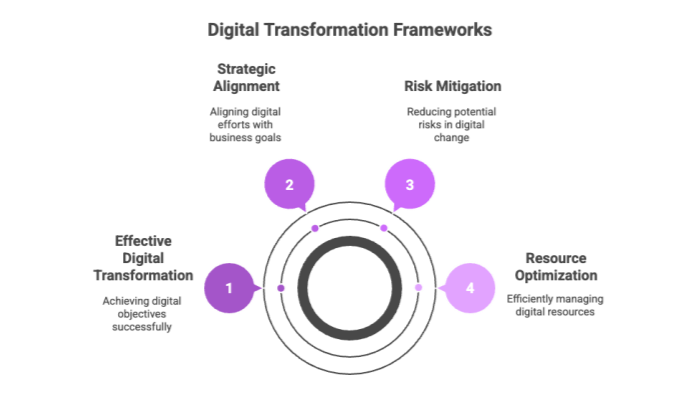

Understanding Digital Transformation Frameworks
Digital transformation frameworks serve as structured guides that enable organizations to plan and execute their digital initiatives effectively. These frameworks support organizations in adapting their strategies and investments to align with their digital transformation goals. But what exactly does a digital transformation framework entail, and why is it so vital in today’s business landscape?
At their core, digital transformation frameworks help businesses navigate the complex process of digital change by providing a clear roadmap. They aid in identifying and mitigating risks associated with digital initiatives, ensuring that efforts are aligned with the overall business strategy. This alignment is crucial for the efficient use of resources and for achieving the desired transformation outcomes.
Moreover, a digital transformation framework can significantly enhance an organization’s approach to adopting new technologies. These frameworks provide strategic guidance, enabling organizations to better achieve their business objectives and maximize the impact of digital technologies. Essentially, a well-structured framework acts as a blueprint, guiding organizations on their transformation journey and helping them stay ahead in the digital age.
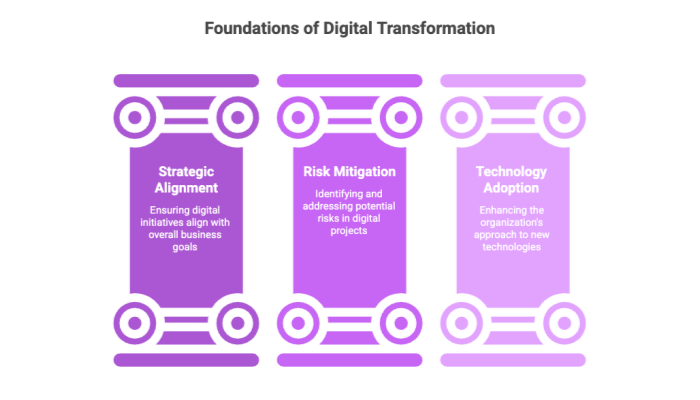

Importance of Digital Transformation Frameworks
Digital transformation frameworks provide a strategic direction, helping organizations set goals and identify areas for improvement. By offering a clear roadmap to innovate and adapt, these frameworks ensure that digital transformation efforts are aligned with business strategies. This alignment is essential for unlocking innovation potential and ensuring successful change implementation.
One of the key benefits of embracing a digital transformation framework includes:
-
The ability to identify potential risks early in the transformation process, enabling proactive risk management.
-
Facilitating better decision-making by promoting data-driven and evidence-based choices.
-
Enhancing collaboration among stakeholders and departments, unifying efforts towards common goals.
Having a digital transformation framework streamlines processes and tracks performance, which aids in optimizing organizational resources. It provides a roadmap for navigating disruptions and ensures that every step taken is in line with the overall digital transformation strategy. This approach allows organizations to successfully transform and stay competitive in the ever-evolving digital landscape.
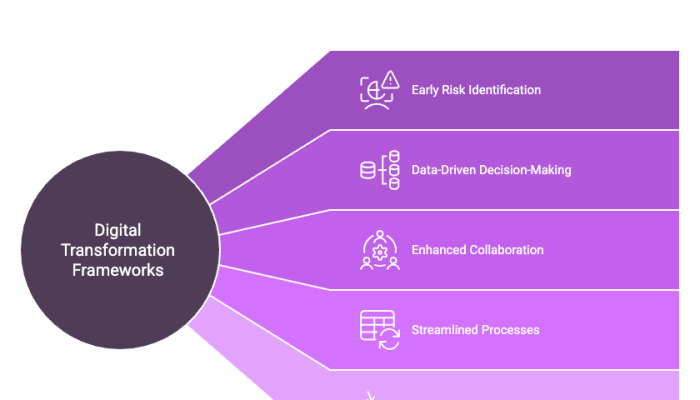

Key Components of an Effective Digital Transformation Framework
An effective digital transformation framework includes several key components that are critical for success. These components encompass customer relations, processes and systems, products and services, and the organization itself. Gartner’s digital transformation framework, for example, emphasizes commitment, leadership, strategy, technology, and creativity as essential strategic elements.
Data-driven decision-making, customer experience, and operational efficiency are highlighted in KPMG’s Digital Delta framework as vital for strategy formulation. Technologies incorporated into a digital transformation framework should be scalable and flexible, capable of adapting to future changes. Collecting data about customer behavior, operational performance, and market trends is essential for driving technological strategies.
Seamless integration of new technologies into existing systems is crucial to avoid disruptions during the transformation process. An effective digital transformation framework acts as a blueprint, guiding organizations on the prioritization and assessment of current processes. Governance frameworks, including policies, standards, and procedures, are necessary to guide efforts and maintain control during digital transformation.
Successful digital transformation also requires omnichannel interaction and services to enhance customer engagement.
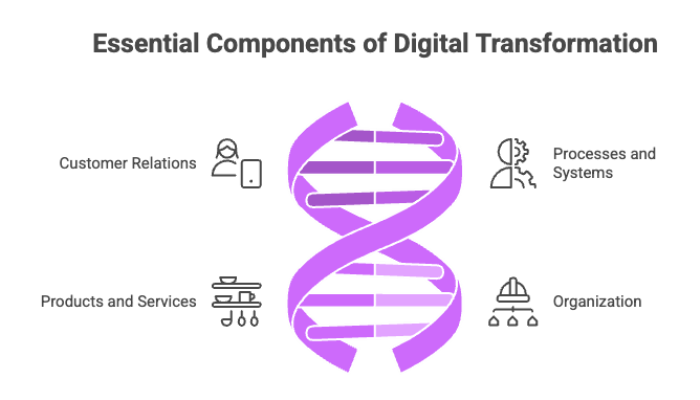

Types of Digital Transformation Frameworks
Digital transformation frameworks provide essential guidance for organizations embarking on digital initiatives, ensuring alignment with business objectives. There are various types of digital transformation frameworks that cater to different aspects of business transformation.
These include:
-
Strategic frameworks like the strategic pillar model
-
Operational frameworks such as Deloitte’s Digital Transformation Framework
-
Capability-focused frameworks like capability maturity frameworks
Some frameworks include:
-
The Digital Platform Strategy, which helps traditional companies adapt to new business models.
-
Frameworks focusing on specific technologies to enhance operational efficiency.
-
Governance frameworks, like the Digital Transformation Governance framework, which ensure that digital initiatives remain effective and aligned with strategic goals.
Each type of framework serves a unique purpose, and selecting the right one depends on the specific needs and goals of the organization.
Enterprise Architecture Frameworks
Enterprise architecture frameworks guide large organizations in systematic digital transformations, aligning with strategic goals. These frameworks assist organizations in aligning their digital strategies with overall business objectives, ensuring that every digital transformation initiative supports the broader corporate strategy.
One prominent example of an enterprise architecture framework is The Open Group Architecture Framework (TOGAF), which provides a comprehensive approach to planning, implementing, and governing enterprise information architecture.
McKinsey’s strategy for a high-performing digital enterprise includes six building blocks:
-
Strategy
-
Customer decision journey
-
Process automation
-
Organizational alignment
-
Technology
-
Data and analytics
These components collectively ensure a robust and effective critical component of digital transformation.
Process Improvement Frameworks
Process improvement frameworks are essential for enhancing operational efficiency and ensuring adaptability during digital transformation. An agile and iterative approach to digital transformation emphasizes the ability to adapt quickly to market changes, structuring the transformation journey in smaller phases that can be adjusted and optimized as needed, including process optimization.
Lean Six Sigma, for instance, focuses on continuous improvement and operational excellence by removing waste and ensuring enhance efficiency in resource allocation.
The Agile Innovation Business Model, guided by five core principles, enhances adaptability and response to market demands, fostering a culture of flexibility and speed in digital transformation.
Customer-Centric Frameworks
A core objective of customer-centric digital transformation approaches is improving customer experience. The Digital Transformation Strategy framework focuses on emerging technology trends and operational efficiencies to enhance customer experiences, which is central to achieving a competitive advantage in today’s market.
Industries such as financial services, insurance, and retail should focus on enhancing customer value propositions through digital services. Key technologies for digital transformation include:
-
Cloud computing
-
Artificial intelligence
-
Machine learning
-
The Internet of Things
By understanding customer segments, needs, preferences, and pain points, businesses can use these technologies to digitize customer experiences, maximizing customer satisfaction, enhancing customer experience, and improving business processes through a customer centric approach to increase lifetime revenue.
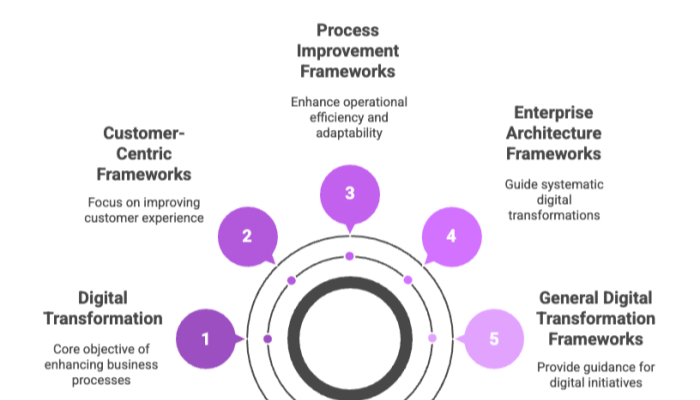

Examples of Leading Digital Transformation Frameworks
The digital transformation frameworks of top consulting firms serve as benchmarks for best practices in the industry. McKinsey’s 4Ds, BCG’s Three-Phase Framework, and Gartner’s Digital Business Framework are among the most influential and widely adopted frameworks. Each of these frameworks provides a unique approach to digital transformation, tailored to address different aspects of the transformation process.
McKinsey’s 4Ds framework focuses on data, design, and distribution as essential components for effective digital transformation. BCG’s Three-Phase Framework employs a three-tiered approach focusing on short-term gains, medium-term plans, and long-term sustainability. Gartner’s Digital Business Framework emphasizes leadership, creativity, and technology integration as critical elements for successful digital transformation.
McKinsey’s 4Ds Framework
McKinsey’s 4Ds framework is centered on data, design, and distribution as essential components for driving digital transformation. This framework emphasizes data as a critical asset for informed decision-making, design as a key driver of user experience, and distribution as vital for delivering value at scale.
By focusing on these three pillars, McKinsey’s 4Ds framework provides a comprehensive approach to achieving a successful digital transformation.
BCG’s Three-Phase Framework
Boston Consulting Group’s digital transformation framework employs a three-tiered approach that focuses on short-term capital gains, medium-term plans, and long-term sustainability. The framework consists of separate phases for digital transformation. These include short-term quick wins, medium-term plans, and long-term sustainability. Each phase is designed to deliver immediate results while laying the groundwork for future improvements and ongoing growth.
By following BCG’s structured approach, organizations can achieve a balanced digital transformation that addresses current needs while ensuring future viability. This phased approach allows for incremental progress and continuous improvement, ensuring that the transformation journey is both effective and sustainable.
Gartner’s Digital Business Framework
Gartner’s Digital Business Framework includes components such as leadership, creativity, and technology as essential for successful digital business transformation. By emphasizing these elements, Gartner’s framework ensures that organizations can navigate the complexities of digital transformation and achieve their strategic objectives.
The integration of leadership and creativity fosters innovation, while the focus on innovative technologies ensures that digital initiatives are effectively implemented and managed.
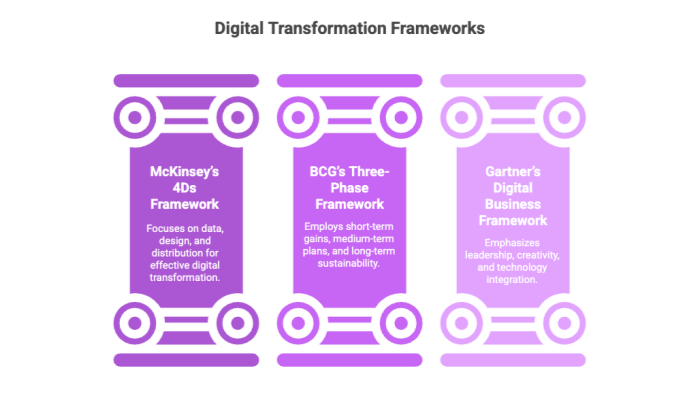
The RAPID Framework
RAPID is a five-phase decision and communication framework—Research, Analyze, Plan, Implement, and Decide—refined over 30 years of consulting and formally published in 2022. It functions as both an intellectual roadmap and an in-app guided system with AI-generated checklists, ensuring each step drives toward clear, measurable outcomes.
Two Flywheels for Continuous Improvement
Flywheel 1 (Research → Analyze)
- Research is an unemotional, methodical diagnostic: gathering hard data (financials, org charts, customer profiles) alongside “passive” insights into company myths and culture.
- Analyze filters that data into “relevant” and “irrelevant” buckets, dives into people, finance, product, and technology, and often loops back to Research to fill gaps.
Flywheel 2 (Plan → Implement → Decide)
- Plan transforms analysis into a tactical roadmap, focusing on people, process, and product.
- Implement puts the plan into action, where real-world feedback drives iterative tweaks.
- Decide is the ongoing verdict on whether actions are delivering the intended results—prompting new plans or deeper implementations as needed.
Core Principles
- Outcome-Orientation: Every phase is aligned to specific business goals, not vanity metrics.
- Fluidity & Adaptation: Decision-making is continuous; wrong turns are expected and quickly corrected.
- Empowerment: Leaders must “decide to no longer decide,” empowering front-line teams to make real-time choices.
- Simplicity in Technology: Tech exists to serve strategy—keep architectures “toaster-simple” and avoid over-engineering.
By embedding RAPID into your operating rhythm, you transform digital initiatives from one-off projects into a self-reinforcing engine for sustained, frictionless growth.
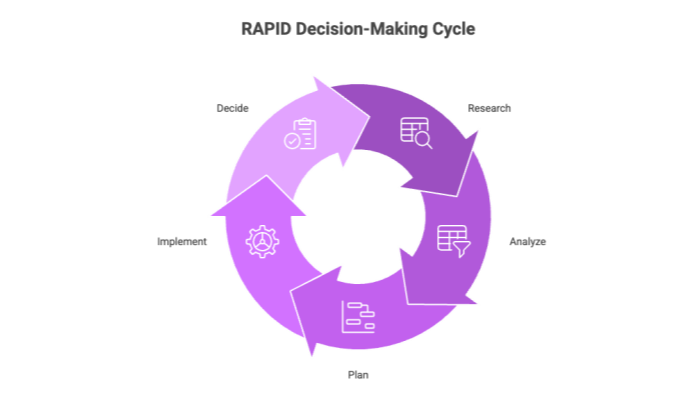

Steps to Creating Your Own Digital Transformation Framework
Creating your own digital transformation framework offers a unique understanding and is tailored to specific business needs. Companies may choose to create their own framework when existing methodologies do not fit all unique challenges. Aligning the digital transformation framework with specific organizational requirements is crucial for success. However, creating a digital transformation framework can feel overwhelming due to significant changes and resource allocation concerns.
The Digital Mastermind framework encourages starting small, thinking big, and scaling fast during digital transformation journeys. A successful digital transformation strategy requires leveraging technology, gaining employee buy-in, and fostering innovation as part of a digital strategy.
The following subsections will guide you through defining your vision and objectives, assessing current digital maturity, and developing a detailed roadmap.
Define Your Vision and Objectives
An effective digital transformation framework should outline clear digital transformation objectives to guide the transformation process. Establishing clear, aligned goals aids in the prioritization of digital transformation initiatives.
A successful digital transformation strategy requires a practical approach that aligns with both internal needs and customer expectations. By defining a clear vision and setting achievable objectives, businesses can ensure that their digital transformation efforts are focused and purposeful.
Assess Current Digital Maturity
A thorough examination of current digital capabilities is crucial for determining transformation gaps. During the assessment, businesses need to:
-
Comprehend their current technology landscape.
-
Evaluate their skill sets and cultural readiness for change.
-
Identify gaps between current and desired states to prioritize efforts and resources effectively.
-
Identify areas that need urgent focus to establish a foundation.
This baseline is essential for tracking progress.
Additionally, organizations can track their progress in digital transformation by conducting regular evaluations. Continuous assessment helps in adjusting strategies and ensuring that the digital transformation journey remains aligned with the overall business goals. Understanding current digital maturity enables businesses to make informed decisions about the steps and investments needed for successful transformation.
Develop a Detailed Roadmap
A digital transformation roadmap:
-
Serves to outline the purpose and key objectives of the transformation efforts.
-
Requires deciding on necessary technologies to align with the outlined objectives.
-
Outlines the sequence of initiatives and aims to reduce risk during implementation.
-
Should incorporate timelines and allocate responsibilities for execution.
A clear roadmap ensures a structured and coordinated approach to digital transformation, leading to optimized organizational efficiency.
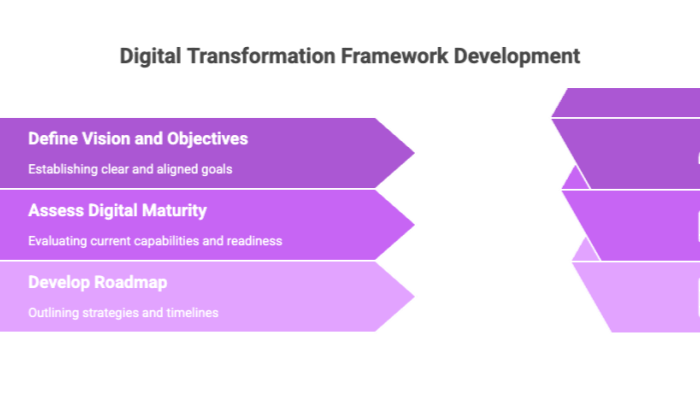

Common Challenges and How to Overcome Them
Fostering a culture of adaptability is essential for successful digital transformation. Key elements include:
-
Continuous innovation, as businesses should remain flexible and responsive to market changes.
-
Cultivating a culture of innovation to sustain transformation and maintain agility.
-
Overcoming siloed departments that often hinder collaboration, which is vital for effective digital transformation.
A common challenge is the ability to communicate in a language that aligns with the digital transformation framework. Strategies to address this include:
-
Establishing a system for continuous monitoring to help organizations adjust their digital strategies effectively.
-
Providing employees with adequate training and resources to ensure their involvement in digital transformation.
-
Creating a dedicated change leadership team to facilitate a smoother transition during digital transformation.
Effective governance and strong leadership are essential to maintain momentum and accountability in digital transformation. Addressing these challenges with effective solutions enables organizations to establish governance, overcome obstacles, and successfully transform. Continuous monitoring, employee training, and strong leadership are key to navigating the complexities of digital transformation.
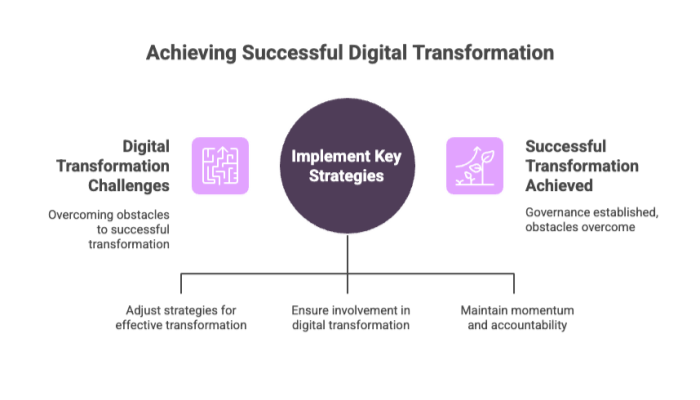

Success Stories: Companies Excelling in Digital Transformation
Digital transformation is crucial for businesses to remain competitive and meet evolving customer demands. Several companies have excelled in their digital transformation efforts, setting examples for others to follow. Microsoft, Nike, and Domino’s are among the companies that have successfully navigated their digital transformation journeys.
These companies have leveraged digital technologies to enhance their operations, improve customer experiences, and achieve significant growth. The following subsections will delve into the specific digital transformation strategies of Microsoft’s shift to cloud computing, Nike’s data-driven personalization, and Domino’s digital ordering innovations.
These success stories demonstrate the potential of digital technology transformation to drive significant improvements in business world success and embracing digital transformation innovation.
Microsoft’s Cloud Computing Shift
In a significant pivot, Microsoft moved from traditional software models to cloud computing, enabling scalable, on-demand access to resources. This transition not only transformed Microsoft’s product offerings but also positioned the company as a leader in the digital services arena.
Microsoft’s shift to cloud computing illustrates a critical change in business strategy, reflecting broader trends in digital transformation across industries. Embracing digital change has allowed Microsoft to leverage technology effectively, staying ahead of market trends and meeting evolving customer needs.
Nike’s Data-Driven Personalization
Nike built a digital ecosystem that includes e-commerce, apps, and personalized shopping experiences. Nike’s app delivers products directly to consumers and offers personalized experiences and recommendations through data analytics. These app capabilities allow Nike to tailor shopping experiences to individual preferences and behaviors, enhancing customer engagement.
Leveraging data-driven insights has enabled Nike to enhance customer experience and strengthen its market position.
Domino’s Digital Ordering Innovations
Key innovations at Domino’s include online and app ordering systems that allow customers to place orders conveniently. AI chatbots were integrated to provide quick and efficient responses to customer inquiries, enhancing the overall interaction.
Voice-activated ordering systems enable customers to place orders using voice commands, streamlining the ordering process. Domino’s focus on improving user experience through various digital ordering innovations has positioned the company as a leader in the digital transformation landscape.
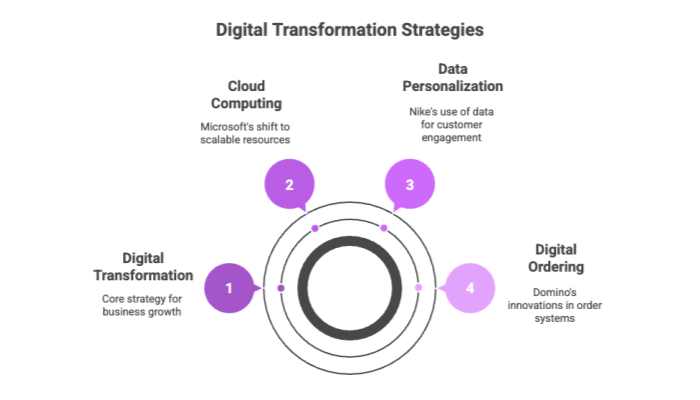

Factors to Consider When Choosing a Digital Transformation Framework
When selecting a digital transformation framework, organizations should ensure the following:
-
The chosen framework aligns with their specific goals and provides clarity on intended outcomes.
-
The selected model supports organizational goals and objectives, ensuring alignment with the overall business strategy.
-
Budget considerations are addressed, with the framework matching the resources available for digital transformation initiatives.
Legal constraints and industry regulations are significant factors that can affect the technology adoption choices made during transformation. The selected new technology should empower companies to analyze data effectively, personalize customer interactions, and safeguard user information.
Additionally, the technology implemented should facilitate effective job performance and enhance employee efficiency. Considering these factors will help organizations choose the most effective digital transformation framework for their needs.
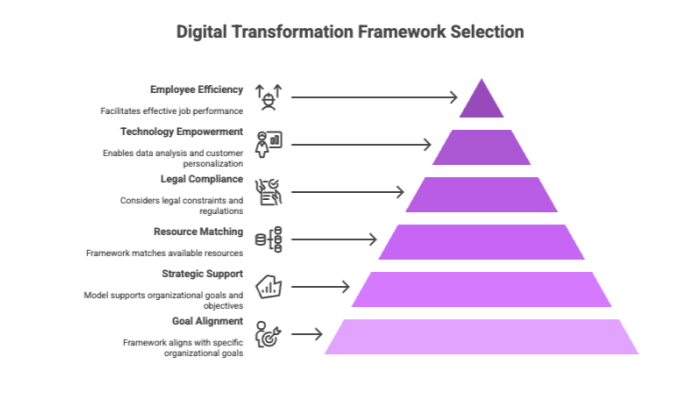

Summary
Digital transformation frameworks are essential tools for guiding organizations through the complex process of digital change. By providing strategic direction, identifying potential risks, and aligning efforts with business objectives, these frameworks ensure that digital transformation initiatives are successful and sustainable. Key components of effective frameworks include customer relations, data-driven decision-making, and seamless technology integration.
In 2025, leveraging the right digital transformation framework can significantly enhance business operations and customer experiences. Whether adopting a well-established framework from a top consulting firm or creating a custom framework tailored to specific needs, businesses must focus on clear objectives, continuous assessment, and strategic planning. By embracing digital transformation and leveraging innovative technologies, organizations can achieve long-term success and stay competitive in the digital age.

Frequently Asked Questions
Digital transformation frameworks serve as essential roadmaps that guide business leaders through the complex process of integrating new digital technologies and digital solutions into their existing processes and operating model.
These frameworks help align digital transformation projects with business and operating models, ensuring that digital transformation means more than just adopting technology—it involves reshaping operational processes and revenue streams to thrive in the evolving digital landscape.
Understanding key performance indicators and leveraging digital tools are critical for tracking progress and achieving digital transformation goals effectively. This FAQ section addresses common questions to help you navigate the strategic and practical aspects of digital transformation frameworks.
What is a digital transformation framework?
A digital transformation framework is a structured guide that enables organizations to effectively plan and execute their digital initiatives, ensuring they align with business goals and strategic objectives. This approach facilitates a smoother transition into the digital age.
Why are digital transformation frameworks important?
Digital transformation frameworks are crucial as they offer strategic direction, foster innovation, and improve decision-making, all while ensuring alignment among stakeholders to achieve successful transformation outcomes.
What are the key components of an effective digital transformation framework?
An effective digital transformation framework includes critical components such as customer relations, processes and systems, products and services, organizational structure, data-driven decision-making, and seamless technology integration. Prioritizing these elements will ensure a comprehensive and successful transformation.
What are some examples of leading digital transformation frameworks?
Some leading digital transformation frameworks include McKinsey's 4Ds, BCG's Three-Phase Framework, and Gartner's Digital Business Framework, each providing distinct methodologies for navigating the transformation process.
How can I create my own digital transformation framework?
To create your own digital transformation framework, begin by defining your vision and objectives, then assess your current digital maturity. Develop a detailed roadmap that aligns with your organization's needs and incorporates innovative technologies.

